Walbank F.W., Astin A.E., Frederiksen M.W., Ogilvie R.M. The Cambridge Ancient History, Volume 7, Part 1: The Hellenistic World
Подождите немного. Документ загружается.

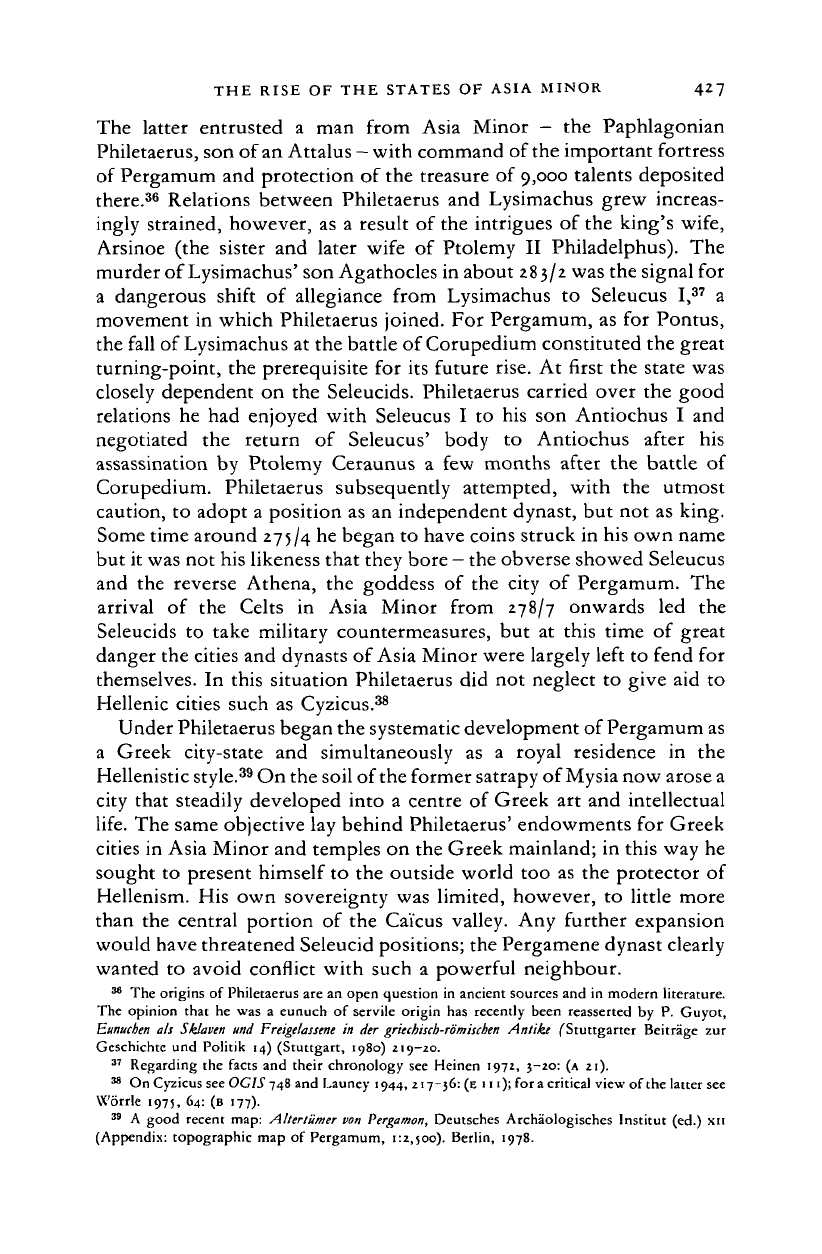
THE RISE OF THE STATES OF ASIA MINOR 427
The latter entrusted
a
man
from Asia Minor
-
the
Paphlagonian
Philetaerus, son of an Attalus
-
with command of
the
important fortress
of Pergamum
and
protection
of
the treasure
of
9,000 talents deposited
there.
36
Relations between Philetaerus
and
Lysimachus grew increas-
ingly strained, however,
as a
result
of
the intrigues
of
the king's wife,
Arsinoe
(the
sister
and
later wife
of
Ptolemy
II
Philadelphus).
The
murder of Lysimachus' son Agathocles in about 283/2 was the signal
for
a dangerous shift
of
allegiance from Lysimachus
to
Seleucus
I,
37
a
movement
in
which Philetaerus joined.
For
Pergamum,
as for
Pontus,
the fall
of
Lysimachus
at
the battle
of
Corupedium constituted the great
turning-point,
the
prerequisite
for its
future rise.
At
first
the
state
was
closely dependent
on the
Seleucids. Philetaerus carried over
the
good
relations
he had
enjoyed with Seleucus
I to
his son
Antiochus
I
and
negotiated
the
return
of
Seleucus' body
to
Antiochus after
his
assassination
by
Ptolemy Ceraunus
a
few
months after
the
battle
of
Corupedium. Philetaerus subsequently attempted, with
the
utmost
caution,
to
adopt
a
position
as an
independent dynast,
but not as
king.
Some time around 275/4 he began
to
have coins struck
in
his own name
but
it
was not his likeness that they bore
—
the obverse showed Seleucus
and
the
reverse Athena,
the
goddess
of
the
city
of
Pergamum.
The
arrival
of
the
Celts
in
Asia Minor from 278/7 onwards
led the
Seleucids
to
take military countermeasures,
but
at
this time
of
great
danger the cities and dynasts
of
Asia Minor were largely left
to
fend
for
themselves.
In
this situation Philetaerus
did not
neglect
to
give
aid to
Hellenic cities such
as
Cyzicus.
38
Under Philetaerus began the systematic development of Pergamum as
a Greek city-state
and
simultaneously
as a
royal residence
in the
Hellenistic style.
39
On the soil of the former satrapy of Mysia now arose
a
city that steadily developed into
a
centre
of
Greek
art and
intellectual
life.
The same objective lay behind Philetaerus' endowments
for
Greek
cities
in
Asia Minor and temples
on
the Greek mainland;
in
this way
he
sought
to
present himself to
the
outside world
too as the
protector
of
Hellenism.
His own
sovereignty
was
limited, however,
to
little more
than
the
central portion
of
the
Caicus valley.
Any
further expansion
would have threatened Seleucid positions; the Pergamene dynast clearly
wanted
to
avoid conflict with such
a
powerful neighbour.
36
The origins
of
Philetaerus are
an
open question
in
ancient sources and
in
modern literature.
The opinion that
he was a
eunuch
of
servile origin
has
recently been reasserted
by P.
Guyot,
Eunucben
als
Sklavtn
und
Freigelaisine
in
der
gritchiscb-romischen Antike (Stuttgarter Beitrage
zur
Geschichte
und
Politik 14) (Stuttgart, 1980) 219-20.
37
Regarding
the
facts
and
their chronology see Heinen 1972, 3-20: (A
21).
38
On Cyzicus see OGW 748 and Launey 1944, 217-36:
(E I
I
1);
for a critical view of the latter see
Vt'orrle 1975, 64: (B 177).
39
A
good recent map: Alttrliimer
von
Pergamon,
Deutsches Archaologisches Institut (ed.)
xn
(Appendix: topographic map
of
Pergamum,
1:2,500).
Berlin, 1978.
Cambridge Histories Online © Cambridge University Press, 2008
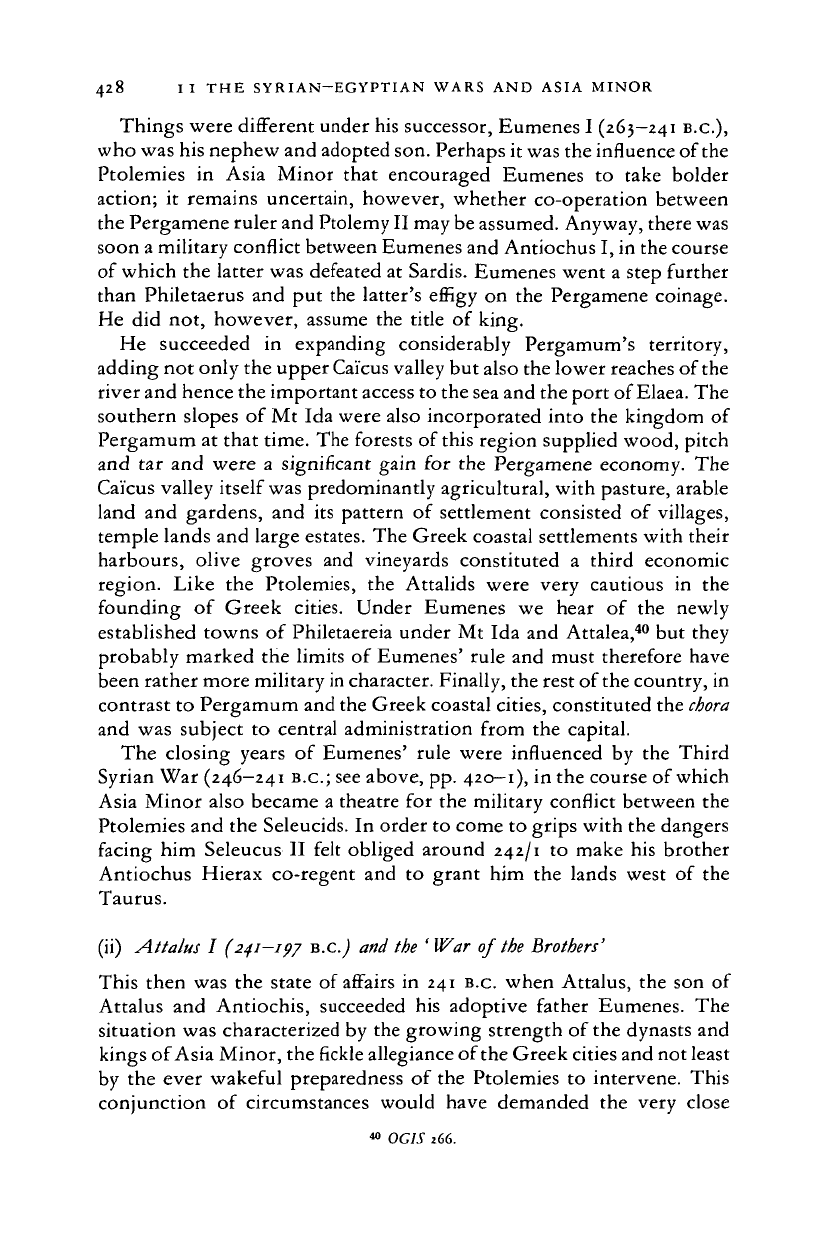
428 II THE SYRIAN-EGYPTIAN WARS AND ASIA MINOR
Things were different under his successor, Eumenes I (263-241 B.C.),
who was his nephew and adopted son. Perhaps it was the influence of the
Ptolemies
in
Asia Minor that encouraged Eumenes
to
take bolder
action;
it
remains uncertain, however, whether co-operation between
the Pergamene ruler and Ptolemy II may be assumed. Anyway, there was
soon a military conflict between Eumenes and Antiochus I, in the course
of which the latter was defeated at Sardis. Eumenes went a step further
than Philetaerus and put the latter's effigy on the Pergamene coinage.
He did not, however, assume the title of king.
He succeeded
in
expanding considerably Pergamum's territory,
adding not only the upper
Cai'cus
valley but also the lower reaches of the
river and hence the important access to the sea and the port of Elaea. The
southern slopes of Mt Ida were also incorporated into the kingdom of
Pergamum at that time. The forests of this region supplied wood, pitch
and tar and were
a
significant gain for the Pergamene economy. The
Cai'cus valley itself
was
predominantly agricultural, with pasture, arable
land and gardens, and its pattern
of
settlement consisted
of
villages,
temple lands and large estates. The Greek coastal settlements with their
harbours, olive groves and vineyards constituted
a
third economic
region. Like the Ptolemies, the Attalids were very cautious
in the
founding
of
Greek cities. Under Eumenes
we
hear
of
the newly
established towns of Philetaereia under Mt Ida and Attalea,
40
but they
probably marked the limits of Eumenes' rule and must therefore have
been rather more military
in
character. Finally, the rest of the country, in
contrast to Pergamum and the Greek coastal cities, constituted the
chora
and was subject to central administration from the capital.
The closing years
of
Eumenes' rule were influenced by the Third
Syrian War
(246—241
B.C.; see above, pp. 420—1), in the course of which
Asia Minor also became a theatre for the military conflict between the
Ptolemies and the Seleucids. In order to come to grips with the dangers
facing him Seleucus
II
felt obliged around 242/1 to make his brother
Antiochus Hierax co-regent and
to
grant him the lands west
of
the
Taurus.
(ii) Attains
I
(241-ip/ B.C.,) and the 'War of
the
Brothers'
This then was the state of affairs in 241
B.C.
when Attalus, the son of
Attalus and Antiochis, succeeded his adoptive father Eumenes. The
situation was characterized by the growing strength of the dynasts and
kings of Asia Minor, the
fickle
allegiance of the Greek cities and not least
by the ever wakeful preparedness of the Ptolemies to intervene. This
conjunction
of
circumstances would have demanded the very close
40
OGIS 166.
Cambridge Histories Online © Cambridge University Press, 2008
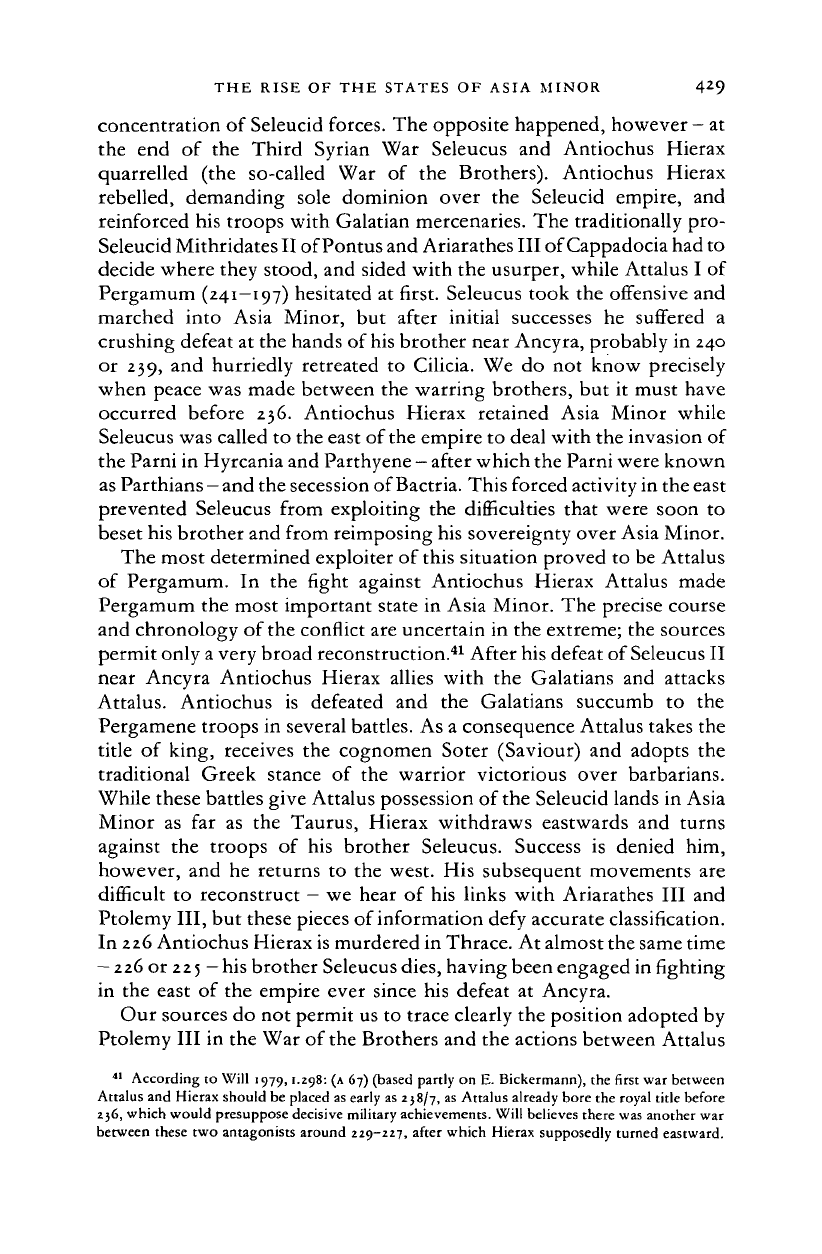
THE RISE OF THE STATES OF ASIA MINOR 4
2
9
concentration
of
Seleucid forces. The opposite happened, however
—
at
the
end of the
Third Syrian
War
Seleucus
and
Antiochus Hierax
quarrelled
(the
so-called
War of the
Brothers). Antiochus Hierax
rebelled, demanding sole dominion over
the
Seleucid empire,
and
reinforced his troops with Galatian mercenaries. The traditionally pro-
Seleucid Mithridates II of Pontus and Ariarathes III of Cappadocia had to
decide where they stood, and sided with the usurper, while Attalus
I of
Pergamum (241-197) hesitated
at
first. Seleucus took the offensive and
marched into Asia Minor,
but
after initial successes
he
suffered
a
crushing defeat at the hands of
his
brother near Ancyra, probably in 240
or 239,
and
hurriedly retreated
to
Cilicia.
We do not
know precisely
when peace was made between the warring brothers,
but it
must have
occurred before
236.
Antiochus Hierax retained Asia Minor while
Seleucus was called to the east of
the
empire to deal with the invasion of
the Parni in Hyrcania and Parthyene
—
after which the Parni were known
as Parthians
—
and the secession of Bactria. This forced activity in the east
prevented Seleucus from exploiting
the
difficulties that were soon
to
beset his brother and from reimposing his sovereignty over Asia Minor.
The most determined exploiter
of
this situation proved to be Attalus
of Pergamum.
In the
fight against Antiochus Hierax Attalus made
Pergamum the most important state
in
Asia Minor. The precise course
and chronology
of
the conflict are uncertain
in
the extreme; the sources
permit only
a
very broad reconstruction.
41
After his defeat of Seleucus II
near Ancyra Antiochus Hierax allies with
the
Galatians
and
attacks
Attalus. Antiochus
is
defeated
and the
Galatians succumb
to the
Pergamene troops in several battles. As a consequence Attalus takes the
title
of
king, receives
the
cognomen Soter (Saviour)
and
adopts
the
traditional Greek stance
of the
warrior victorious over barbarians.
While these battles give Attalus possession of the Seleucid lands in Asia
Minor
as far as the
Taurus, Hierax withdraws eastwards
and
turns
against
the
troops
of his
brother Seleucus. Success
is
denied
him,
however,
and he
returns
to the
west.
His
subsequent movements
are
difficult
to
reconstruct
—
we hear
of
his links with Ariarathes
III and
Ptolemy III, but these pieces of information defy accurate classification.
In 226 Antiochus Hierax is murdered in Thrace. At almost the same time
-
226
or
225
-his brother Seleucus dies, having been engaged in fighting
in
the
east
of
the empire ever since
his
defeat
at
Ancyra.
Our sources do not permit us to trace clearly the position adopted by
Ptolemy III
in
the War
of
the Brothers and the actions between Attalus
41
According
to
Will 1979,1.298:
(A
67) (based partly
on
E. Bickermann), the first war between
Attalus and Hierax should be placed as early as 238/7, as Attalus already bore the royal title before
236,
which would presuppose decisive military achievements. Will believes there was another war
between these two antagonists around 229-227, after which Hierax supposedly turned eastward.
Cambridge Histories Online © Cambridge University Press, 2008
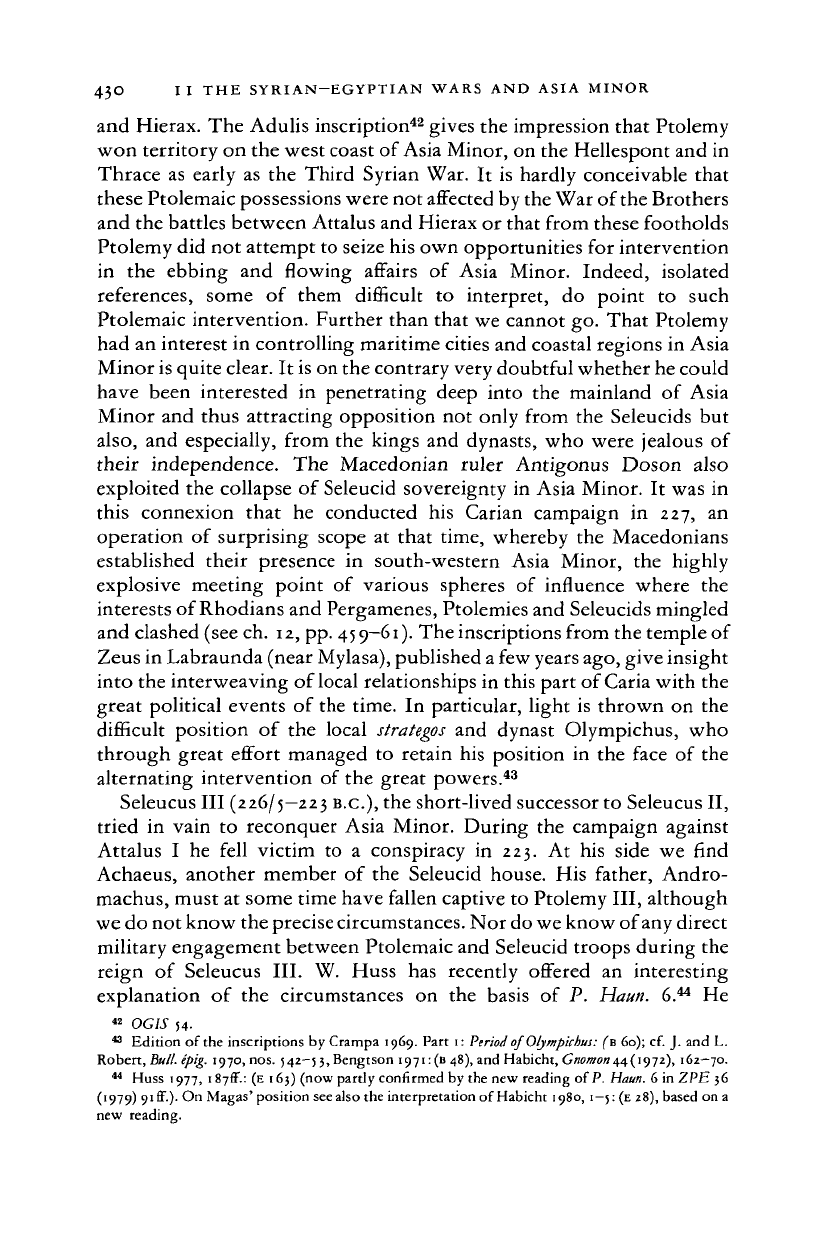
43© I I THE SYRIAN-EGYPTIAN WARS AND ASIA MINOR
and Hierax. The Adulis inscription
42
gives the impression that Ptolemy
won territory on the west coast
of
Asia Minor,
on
the Hellespont and
in
Thrace
as
early
as the
Third Syrian War.
It
is
hardly conceivable that
these Ptolemaic possessions were not affected by the War of the Brothers
and the battles between Attalus and Hierax
or
that from these footholds
Ptolemy did not attempt to seize his own opportunities
for
intervention
in
the
ebbing
and
flowing affairs
of
Asia Minor. Indeed, isolated
references, some
of
them difficult
to
interpret,
do
point
to
such
Ptolemaic intervention. Further than that we cannot go. That Ptolemy
had
an
interest
in
controlling maritime cities and coastal regions in Asia
Minor
is
quite clear.
It
is on the contrary very doubtful whether he could
have been interested
in
penetrating deep into
the
mainland
of
Asia
Minor
and
thus attracting opposition
not
only from
the
Seleucids
but
also,
and
especially, from
the
kings
and
dynasts,
who
were jealous
of
their independence.
The
Macedonian ruler Antigonus Doson also
exploited
the
collapse
of
Seleucid sovereignty
in
Asia Minor.
It
was
in
this connexion that
he
conducted
his
Carian campaign
in
227,
an
operation
of
surprising scope
at
that time, whereby
the
Macedonians
established their presence
in
south-western Asia Minor,
the
highly
explosive meeting point
of
various spheres
of
influence where
the
interests of Rhodians and Pergamenes, Ptolemies and Seleucids mingled
and clashed (see ch. 12, pp.
45
9—61).
The inscriptions from the temple of
Zeus in Labraunda (near Mylasa), published
a
few years ago, give insight
into the interweaving
of
local
relationships
in
this part
of
Caria with
the
great political events
of
the time.
In
particular, light
is
thrown
on the
difficult position
of
the
local
strategos
and
dynast Olympichus,
who
through great effort managed
to
retain
his
position
in the
face
of the
alternating intervention
of the
great powers.
43
Seleucus
III
(226/5-223
B.C.),
the short-lived successor to Seleucus
II,
tried
in
vain
to
reconquer Asia Minor. During
the
campaign against
Attalus
I he
fell victim
to a
conspiracy
in
223.
At
his
side
we
find
Achaeus, another member
of
the
Seleucid house.
His
father, Andro-
machus, must
at
some time have fallen captive
to
Ptolemy III, although
we do not know the precise circumstances. Nor do we know of any direct
military engagement between Ptolemaic and Seleucid troops during
the
reign
of
Seleucus
III. W.
Huss
has
recently offered
an
interesting
explanation
of
the
circumstances
on
the
basis
of
P.
Haun.
6.
44
He
42
OGIS
54-
43
Edition
of
the inscriptions
by
Crampa 1969. Part
1:
Period
of
Olympichus:
(B
60);
cf.
J.
and
L.
Robert, Bull. ipig. 1970, nos. 542-5
3,
Bengtson 1971:
(B
48),
and
Habicht, Gnomon44(1972), 162—70.
44
Huss 1977, 187s".: (E 163) (now partly confirmed by the new reading
of
P. Haun.
6 in ZPE
36
(1979) 91
ff.).
On Magas'position see also the interpretation of Habicht 1980, 1-5:
(E
28), based on
a
new reading.
Cambridge Histories Online © Cambridge University Press, 2008

THE RISE OF THE STATES OF ASIA MINOR 43 I
suggests that after the death of Seleucus III his successor Antiochus III
directed Achaeus to reconquer Asia Minor and that Ptolemy III sent his
son Magas to oppose him in support of Attalus. The Ptolemaic
intervention could not, however, prevent the Seleucid troops from
driving Attalus back to the confines of Pergamum in 223/2. As K. J.
Beloch surmised, the Ptolemaic support for Attalus may have been one
of the grounds on which Antiochus III launched the Fourth Syrian War.
Before we turn our attention to this conflict, however, let us take
another look at the situation of Attalus I. These were years of dramatic
fluctuations in his fortunes. Pergamum emerged strengthened from the
clash with Antiochus Hierax and the Galatians. The period from 226 to
223 B.C. marked one of the high points of Attalus' reign. He presented
his victories over the Galatians
as
an important achievement and posed as
the champion of Greek civilization against barbarism (see also above,
pp.
423-5). The latter Attalids emulated him in this regard; the
Galatian monuments and the figures for the 'Pergamum altar' (first half
of the second century B.C.) present this view in an artistically striking
manner (Plates vol., pis. 60-3). In the Pergamene kings' conception of
themselves the Galatians came to occupy the place that had once been
filled by the Persians in the political thought and art of Athens. This is
not simply proof of the power of attraction of Hellenic culture, which
the half-Greek Attalids espoused with missionary zeal; it is also a
delicately calculated play on the barbarian theme. The ideology that
found such an impressive manifestation in art should not blind us to the
fact that the dynasts of Asia Minor, such as Antiochus Hierax and not
least of all the Attalids, themselves took Galatian troops into their
service.
The successes of Attalus I in battle first against Antiochus Hierax and
the Galatians and then against Seleucus III were short-lived, however.
We have seen how swiftly Achaeus destroyed Attalus' dream of
becoming a major power.
The tying down of Seleucid forces first in the upper satrapies and then
in the Fourth Syrian War (221—217 B.C.) gave Achaeus a free hand as far
as his position and activities in Asia Minor were concerned. In the
autumn of 220 he had himself proclaimed king in Laodicea in Phrygia,
thus finalizing the break with Antiochus III. At the same time there was
clearly a rapprochement between Achaeus and Attalus, for both
emerged as allies of Byzantium in the war that broke out between
Rhodes and Byzantium in 220 (see below, pp. 433, 440). This arrange-
ment lasted only a short time, however, as in 218 Attalus took advantage
of Achaeus' commitments in Pisidia to regain lost territory. At that time
he took the Greek cities of northern Ionia, Aeolis and Troas and the
Cambridge Histories Online © Cambridge University Press, 2008
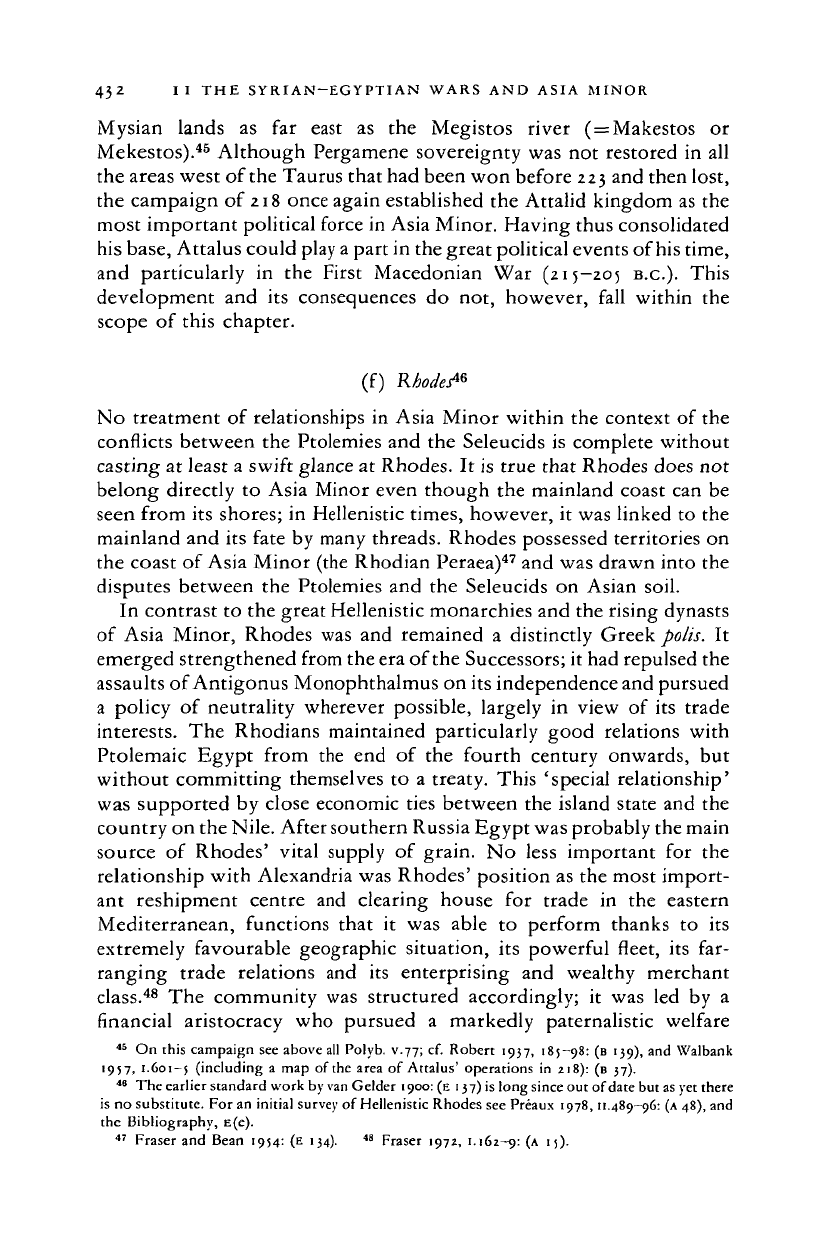
432 II THE SYRIAN-EGYPTIAN WARS AND ASIA MINOR
Mysian lands
as far
east
as the
Megistos river ( = Makestos
or
Mekestos).
45
Although Pergamene sovereignty was not restored in all
the areas west of
the
Taurus that had been won before 223 and then lost,
the campaign of 218 once again established the Attalid kingdom as the
most important political force in Asia Minor. Having thus consolidated
his base, Attalus could play
a
part in the great political events of his time,
and particularly
in
the First Macedonian War (215—205 B.C.). This
development and
its
consequences do not, however, fall within the
scope of this chapter.
(f) Rhodes
46
No treatment of relationships in Asia Minor within the context of the
conflicts between the Ptolemies and the Seleucids is complete without
casting at least a swift glance at Rhodes. It is true that Rhodes does not
belong directly to Asia Minor even though the mainland coast can be
seen from its shores; in Hellenistic times, however, it was linked to the
mainland and its fate by many threads. Rhodes possessed territories on
the coast of Asia Minor (the Rhodian Peraea)
47
and was drawn into the
disputes between the Ptolemies and the Seleucids on Asian soil.
In contrast to the great Hellenistic monarchies and the rising dynasts
of Asia Minor, Rhodes was and remained
a
distinctly Greek
polis.
It
emerged strengthened from the era of the Successors; it had repulsed the
assaults of Antigonus Monophthalmus on its independence and pursued
a policy
of
neutrality wherever possible, largely
in
view
of
its trade
interests. The Rhodians maintained particularly good relations with
Ptolemaic Egypt from the end
of
the fourth century onwards, but
without committing themselves to a treaty. This 'special relationship'
was supported by close economic ties between the island state and the
country on the Nile. After southern Russia Egypt was probably the main
source
of
Rhodes' vital supply
of
grain. No less important
for
the
relationship with Alexandria was Rhodes' position as the most import-
ant reshipment centre and clearing house
for
trade
in
the eastern
Mediterranean, functions that
it
was able
to
perform thanks
to its
extremely favourable geographic situation, its powerful fleet, its far-
ranging trade relations and
its
enterprising and wealthy merchant
class.
48
The community was structured accordingly;
it
was led by
a
financial aristocracy who pursued
a
markedly paternalistic welfare
45
On this campaign see above all Polyb. v.77; cf. Robert 1937,
185-98:
(B 139), and Walbank
1957,
1.601-j
(including
a
map of the area
of
Attalus' operations
in
218): (B 37).
46
The earlier standard work by van Gelder 1900: (E 137) is long since out of date but as yet there
is
no substitute. For an initial survey of Hellenistic Rhodes see Preaux 1978, 11.489—96:
(A
48), and
the
Bibliography, E(e).
47
Fraser and Bean 1954: (E 134).
4S
Fraser 1972,
1.162-9:
(A IJ).
Cambridge Histories Online © Cambridge University Press, 2008
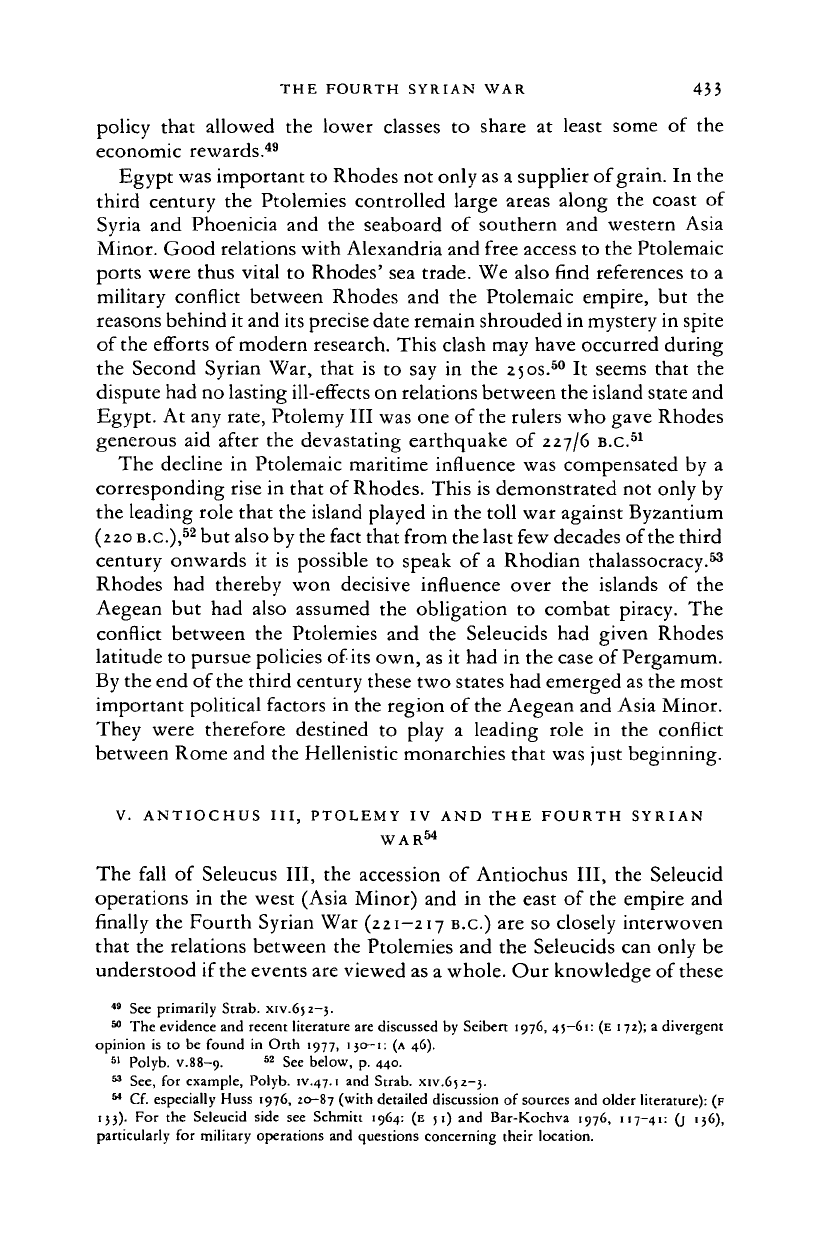
THE FOURTH SYRIAN WAR 45 3
policy that allowed
the
lower classes
to
share
at
least some
of
the
economic rewards.
49
Egypt was important
to
Rhodes
not
only as a supplier of grain.
In the
third century
the
Ptolemies controlled large areas along
the
coast
of
Syria
and
Phoenicia
and the
seaboard
of
southern
and
western Asia
Minor. Good relations with Alexandria and free access
to the
Ptolemaic
ports were thus vital
to
Rhodes'
sea
trade.
We
also find references
to a
military conflict between Rhodes
and the
Ptolemaic empire,
but the
reasons behind it and its precise date remain shrouded in mystery
in
spite
of the efforts
of
modern research. This clash
may
have occurred during
the Second Syrian
War,
that
is
to
say
in
the
250s.
50
It
seems that
the
dispute had no lasting ill-effects on relations between the island state and
Egypt.
At
any rate, Ptolemy
III
was one
of
the rulers who gave Rhodes
generous
aid
after
the
devastating earthquake
of
227/6 B.C.
51
The decline
in
Ptolemaic maritime influence
was
compensated
by
a
corresponding rise
in
that
of
Rhodes.
This
is
demonstrated
not
only
by
the leading role that
the
island played
in the
toll war against Byzantium
(220
B.C.),
52
but also by the fact that from the last
few
decades of the third
century onwards
it is
possible
to
speak
of
a
Rhodian thalassocracy.
53
Rhodes
had
thereby
won
decisive influence over
the
islands
of
the
Aegean
but had
also assumed
the
obligation
to
combat piracy.
The
conflict between
the
Ptolemies
and the
Seleucids
had
given Rhodes
latitude
to
pursue policies
of
its own,
as it had in the
case
of
Pergamum.
By the end
of
the
third century these two states had emerged as the most
important political factors
in the
region
of
the Aegean
and
Asia Minor.
They were therefore destined
to
play
a
leading role
in the
conflict
between Rome
and the
Hellenistic monarchies that
was
just beginning.
V. ANTIOCHUS III, PTOLEMY IV AND THE FOURTH SYRIAN
WAR
54
The fall
of
Seleucus
III, the
accession
of
Antiochus
III, the
Seleucid
operations
in the
west (Asia Minor)
and in the
east
of the
empire
and
finally the Fourth Syrian
War
(221—217
B.C.)
are so
closely interwoven
that
the
relations between
the
Ptolemies
and the
Seleucids
can
only
be
understood
if
the
events are viewed as
a
whole.
Our
knowledge
of
these
49
See
primarily
Strab. xiv.6)2-3.
50
The
evidence
and
recent
literature
are
discussed
by
Seibert
1976, 45-61: (E 172);
a
divergent
opinion
is to be
found
in
Orth
1977, 130-1: (A
46).
51
Polyb. v.88-9.
52
See
below,
p. 440.
53
See,
for
example, Polyb.
iv.47.1
and
Strab. xiv.652-3.
54
Cf.
especially Huss 1976, 20-87 (with detailed discussion
of
sources and older literature): (F
133).
For the
Seleucid side
see
Schmitt 1964:
(E 51) and
Bar-Kochva
1976,
117-41:
(j 136),
particularly
for
military operations
and
questions concerning their location.
Cambridge Histories Online © Cambridge University Press, 2008
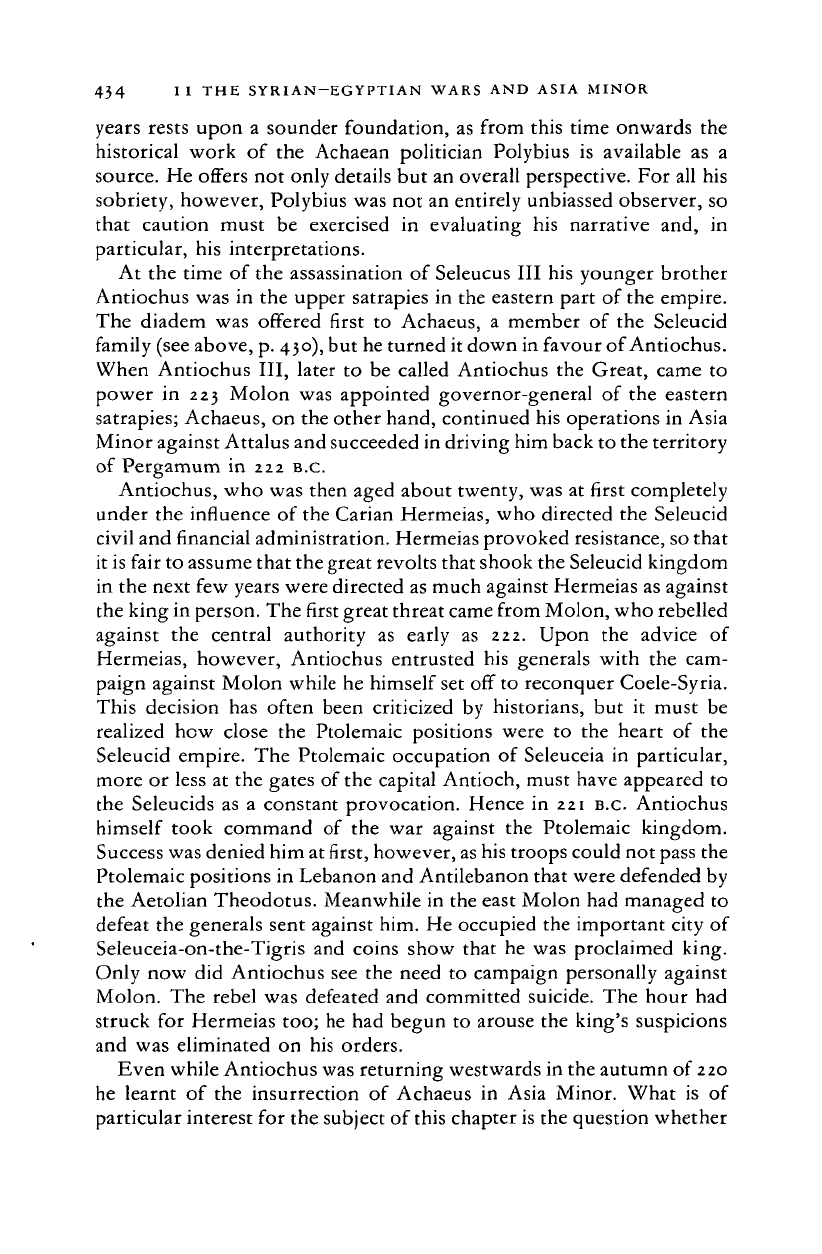
434 I I THE SYRIAN-EGYPTIAN WARS AND ASIA MINOR
years rests upon a sounder foundation, as from this time onwards the
historical work
of
the Achaean politician Polybius
is
available
as a
source. He offers not only details but an overall perspective. For all his
sobriety, however, Polybius was not an entirely unbiassed observer, so
that caution must
be
exercised
in
evaluating
his
narrative and,
in
particular, his interpretations.
At the time of the assassination of Seleucus III his younger brother
Antiochus was in the upper satrapies in the eastern part of the empire.
The diadem was offered first
to
Achaeus,
a
member
of
the Seleucid
family (see above, p. 430), but he turned it down in favour of Antiochus.
When Antiochus III, later to be called Antiochus the Great, came
to
power
in
223 Molon was appointed governor-general
of
the eastern
satrapies; Achaeus, on the other hand, continued his operations in Asia
Minor against Attalus and succeeded in driving him back to the territory
of Pergamum in 222 B.C.
Antiochus, who was then aged about twenty, was at first completely
under the influence of the Carian Hermeias, who directed the Seleucid
civil and financial administration. Hermeias provoked resistance, so that
it is fair to assume that the great revolts that shook the Seleucid kingdom
in the next few years were directed as much against Hermeias as against
the king in person. The first great threat came from Molon, who rebelled
against
the
central authority
as
early
as
222. Upon
the
advice
of
Hermeias, however, Antiochus entrusted his generals with the cam-
paign against Molon while he himself set off to reconquer Coele-Syria.
This decision has often been criticized by historians, but
it
must be
realized hew close the Ptolemaic positions were
to
the heart
of
the
Seleucid empire. The Ptolemaic occupation of Seleuceia in particular,
more or less at the gates of the capital Antioch, must have appeared to
the Seleucids as
a
constant provocation. Hence in 221
B.C.
Antiochus
himself took command
of
the war against the Ptolemaic kingdom.
Success was denied him at first, however, as his troops could not pass the
Ptolemaic positions in Lebanon and Antilebanon that were defended by
the Aetolian Theodotus. Meanwhile in the east Molon had managed to
defeat the generals sent against him. He occupied the important city of
Seleuceia-on-the-Tigris and coins show that he was proclaimed king.
Only now did Antiochus see the need to campaign personally against
Molon. The rebel was defeated and committed suicide. The hour had
struck for Hermeias too; he had begun to arouse the king's suspicions
and was eliminated on his orders.
Even while Antiochus was returning westwards in the autumn of 220
he learnt
of
the insurrection
of
Achaeus
in
Asia Minor. What
is of
particular interest for the subject of this chapter is the question whether
Cambridge Histories Online © Cambridge University Press, 2008
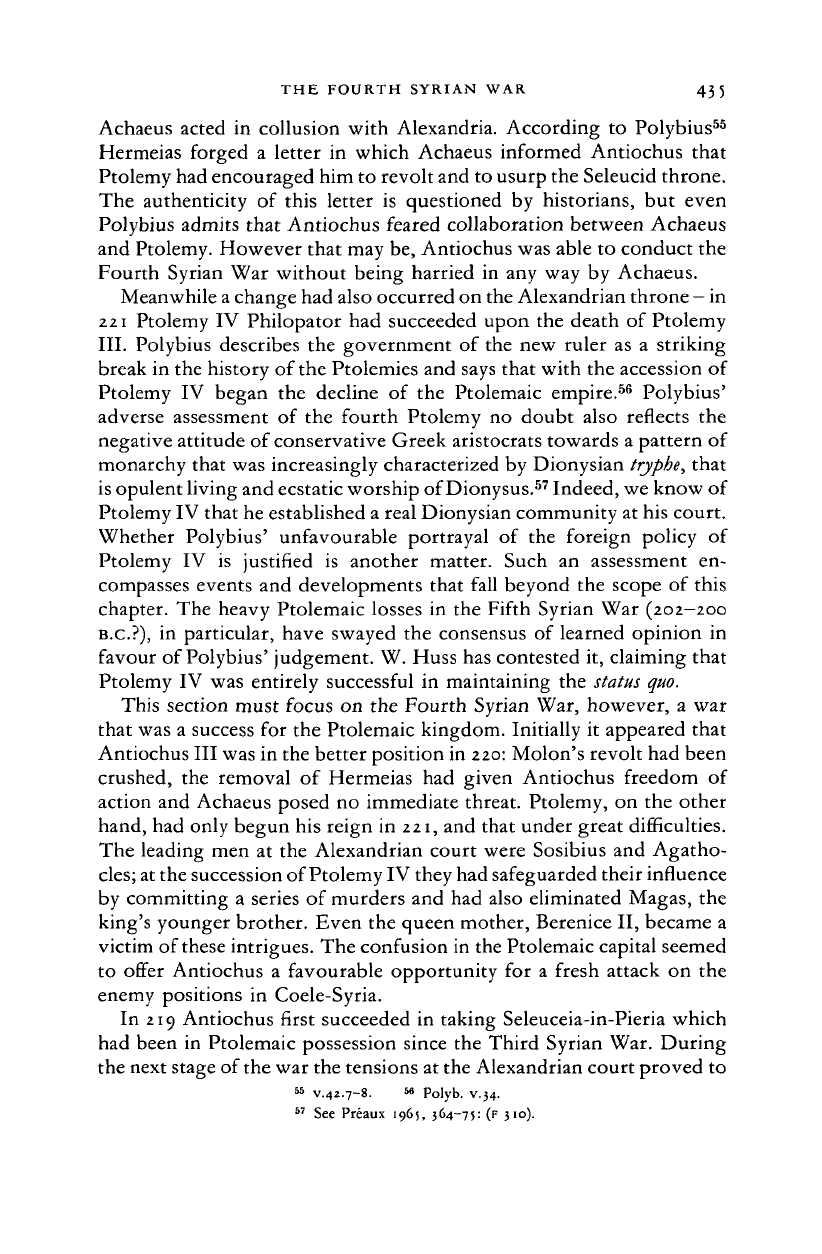
THE FOURTH SYRIAN WAR 435
Achaeus acted in collusion with Alexandria. According to Polybius
55
Hermeias forged a letter in which Achaeus informed Antiochus that
Ptolemy had encouraged him to revolt and to usurp the Seleucid throne.
The authenticity of this letter is questioned by historians, but even
Polybius admits that Antiochus feared collaboration between Achaeus
and Ptolemy. However that may be, Antiochus was able to conduct the
Fourth Syrian War without being harried in any way by Achaeus.
Meanwhile
a
change had also occurred on the Alexandrian throne
—
in
221 Ptolemy IV Philopator had succeeded upon the death of Ptolemy
III.
Polybius describes the government of the new ruler as a striking
break in the history of the Ptolemies and says that with the accession of
Ptolemy IV began the decline of the Ptolemaic empire.
56
Polybius'
adverse assessment of the fourth Ptolemy no doubt also reflects the
negative attitude of conservative Greek aristocrats towards a pattern of
monarchy that was increasingly characterized by Dionysian
tryphe,
that
is opulent living and ecstatic worship of Dionysus.
57
Indeed, we know of
Ptolemy IV that he established a real Dionysian community at his court.
Whether Polybius' unfavourable portrayal of the foreign policy of
Ptolemy IV is justified is another matter. Such an assessment en-
compasses events and developments that fall beyond the scope of this
chapter. The heavy Ptolemaic losses in the Fifth Syrian War (202—200
B.C.?), in particular, have swayed the consensus of learned opinion in
favour of Polybius' judgement. W. Huss has contested it, claiming that
Ptolemy IV was entirely successful in maintaining the
status
quo.
This section must focus on the Fourth Syrian War, however, a war
that was a success for the Ptolemaic kingdom. Initially it appeared that
Antiochus III was in the better position in 220: Molon's revolt had been
crushed, the removal of Hermeias had given Antiochus freedom of
action and Achaeus posed no immediate threat. Ptolemy, on the other
hand, had only begun his reign in
221,
and that under great difficulties.
The leading men at the Alexandrian court were Sosibius and Agatho-
cles;
at the succession of Ptolemy IV they had safeguarded their influence
by committing a series of murders and had also eliminated Magas, the
king's younger brother. Even the queen mother, Berenice II, became a
victim of these intrigues. The confusion in the Ptolemaic capital seemed
to offer Antiochus a favourable opportunity for a fresh attack on the
enemy positions in Coele-Syria.
In 219 Antiochus first succeeded in taking Seleuceia-in-Pieria which
had been in Ptolemaic possession since the Third Syrian War. During
the next stage of
the
war the tensions at the Alexandrian court proved to
55
v.42.7-8.
M
Polyb. v.34.
57
See Preaux 1965, 364-75: (F 310).
Cambridge Histories Online © Cambridge University Press, 2008
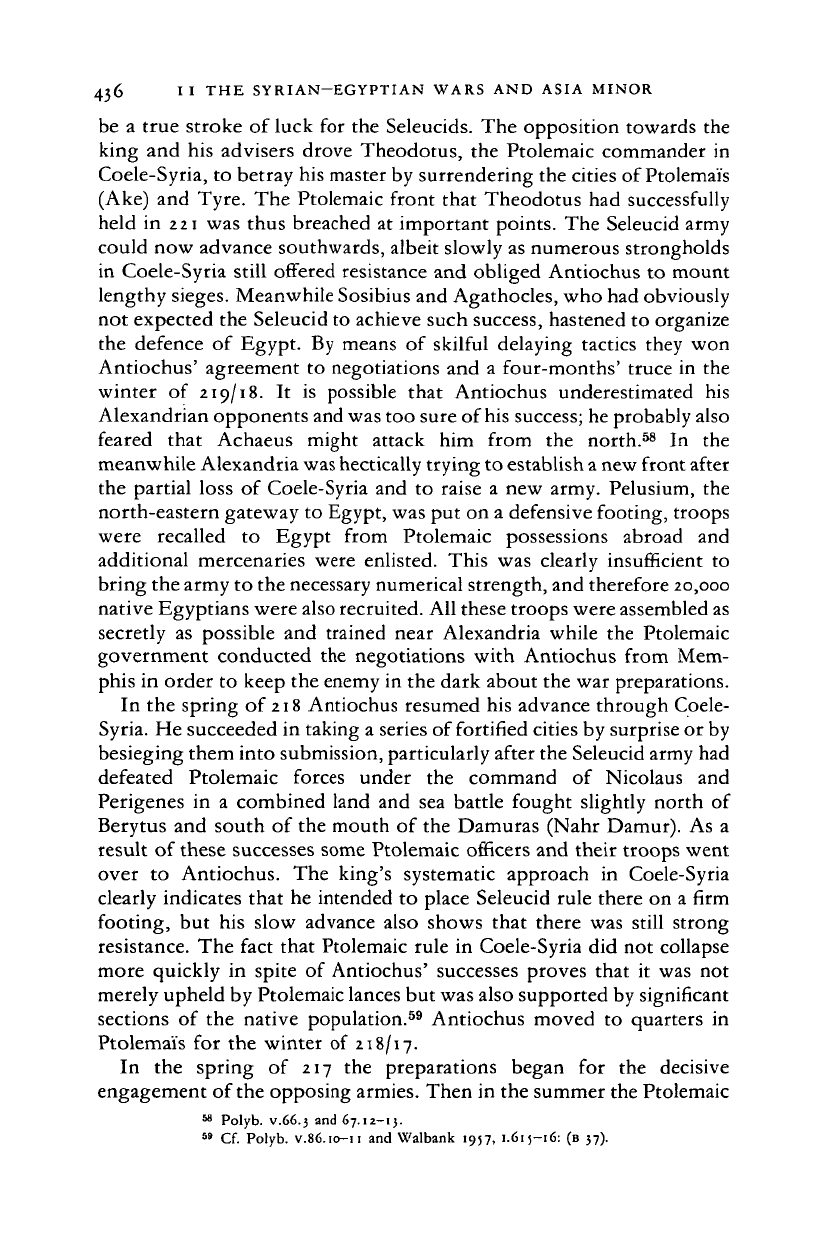
436 II THE SYRIAN-EGYPTIAN WARS AND ASIA MINOR
be a true stroke of luck for the Seleucids. The opposition towards the
king and his advisers drove Theodotus, the Ptolemaic commander in
Coele-Syria, to betray his master by surrendering the cities of Ptolemais
(Ake) and Tyre. The Ptolemaic front that Theodotus had successfully
held in 221 was thus breached at important points. The Seleucid army
could now advance southwards, albeit slowly as numerous strongholds
in Coele-Syria still offered resistance and obliged Antiochus to mount
lengthy sieges. Meanwhile Sosibius and Agathocles, who had obviously
not expected the Seleucid to achieve such success, hastened to organize
the defence
of
Egypt. By means
of
skilful delaying tactics they won
Antiochus' agreement to negotiations and a four-months' truce in the
winter
of
219/18.
It is
possible that Antiochus underestimated
his
Alexandrian opponents and was too sure of
his
success; he probably also
feared that Achaeus might attack him from
the
north.
58
In the
meanwhile Alexandria
was
hectically trying to establish
a
new front after
the partial loss of Coele-Syria and to raise a new army. Pelusium, the
north-eastern gateway to Egypt, was put on a defensive footing, troops
were recalled
to
Egypt from Ptolemaic possessions abroad
and
additional mercenaries were enlisted. This was clearly insufficient
to
bring the army to the necessary numerical strength, and therefore 20,000
native Egyptians were also recruited. All these troops were assembled as
secretly as possible and trained near Alexandria while the Ptolemaic
government conducted the negotiations with Antiochus from Mem-
phis in order to keep the enemy in the dark about the war preparations.
In the spring of 218 Antiochus resumed his advance through Coele-
Syria. He succeeded in taking a series of fortified cities by surprise or by
besieging them into submission, particularly after the Seleucid army had
defeated Ptolemaic forces under
the
command
of
Nicolaus
and
Perigenes
in a
combined land and sea battle fought slightly north of
Berytus and south of the mouth of the Damuras (Nahr Damur). As
a
result of these successes some Ptolemaic officers and their troops went
over
to
Antiochus. The king's systematic approach
in
Coele-Syria
clearly indicates that he intended to place Seleucid rule there on a firm
footing, but his slow advance also shows that there was still strong
resistance. The fact that Ptolemaic rule in Coele-Syria did not collapse
more quickly in spite of Antiochus' successes proves that
it
was not
merely upheld by Ptolemaic lances but was also supported by significant
sections
of
the native population.
59
Antiochus moved to quarters
in
Ptolemai's for the winter of 218/17.
In
the
spring
of
217
the
preparations began
for the
decisive
engagement of the opposing armies. Then in the summer the Ptolemaic
58
Polyb. v.66.3
and
67.12-13.
59
Cf.
Polyb. v.86.10-11
and
Walbank
1957,
1.615-16:
(B 37).
Cambridge Histories Online © Cambridge University Press, 2008
